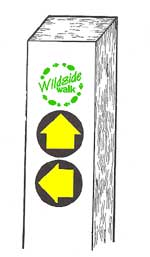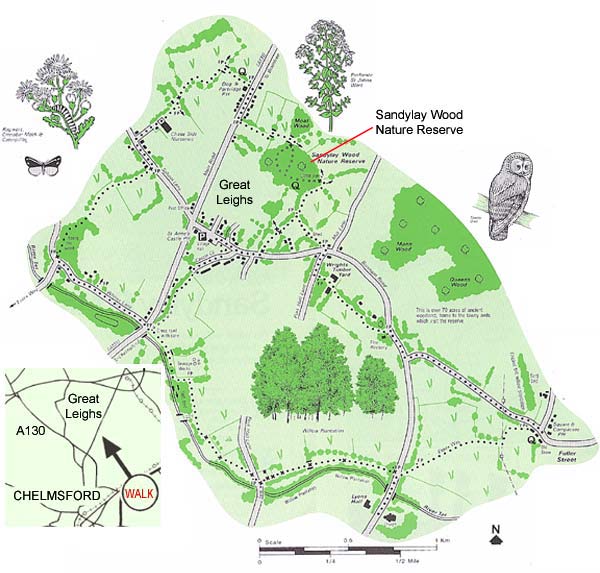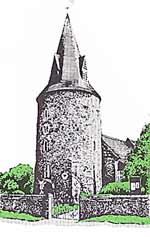Sandylay and Moat Wood Wildside Walk in Great Leighs, Chelmsford - Healthy Life Essex
Home » Articles » Outdoor Life » Countryside in Essex » Country Walking » Sandylay and Moat Wood Wildside Walk in Great Leighs, Chelmsford
No other walk shows you the birth place of Ian Botham’s cricket bats or takes you past Britain’s leading cress producer! Enjoy the attractive countryside around Great Leighs, visit Sandylay and Moat Woods Nature Reserve and follow part of the Essex Way…
Sandylay and Moat Woods
This interesting reserve is ancient woodland with a difference! Observe the native oak, small  leaved lime and hornbeam competing with the introduced conifers, sycamore and poplar. These were planted by the previous owners before the land was donated to the Trust in 1982. The ‘alien’ trees will gradually be removed to return the woodland to a more natural state, better for wildlife. Some of the Norway spruce will be retained as they attract our smallest bird: the goldcrest.
leaved lime and hornbeam competing with the introduced conifers, sycamore and poplar. These were planted by the previous owners before the land was donated to the Trust in 1982. The ‘alien’ trees will gradually be removed to return the woodland to a more natural state, better for wildlife. Some of the Norway spruce will be retained as they attract our smallest bird: the goldcrest.
More visible are tawny owls which roost and hunt in the wood. Owl boxes have been erected to tempt them to set up home. In spring, the woodland floor is awash with wood anemone and primroses, followed later by violet and early purple orchid.
 Wildside Walks are usually ‘Waymarked’, but be aware that some waymarks are now in dis-repair or even missing. They are found on special posts, stiles, gates and some fingerposts. The posts are usually painted white so that they can be seen from a distance (when needing to cross large fields etc this can be very useful. Tip: Binoculars can be handy to have when looking for the white posts.)
Wildside Walks are usually ‘Waymarked’, but be aware that some waymarks are now in dis-repair or even missing. They are found on special posts, stiles, gates and some fingerposts. The posts are usually painted white so that they can be seen from a distance (when needing to cross large fields etc this can be very useful. Tip: Binoculars can be handy to have when looking for the white posts.)
Wildside walk plaques are bright green and unique to Wildside walks in Essex.
Yellow ‘Directional Arrows’ usually on circular disks indicate the direction you should follow. (Path junctions are more complicated! Each arrow indicates an alternative route, so use the map to make your choice.)
Three different types of directional arrow are used:
Plain Yellow: used on ‘official’ public footpaths
Yellow Arrow with Courtesy Footpath: A small number of paths are not ‘official’ public rights of way. Most courtesy paths are in Nature Reserves and are generally provided courtesy of the landowner.
Plain Blue: Used on ‘official’ bridleways. Only found on the Bicknacre walk – look out for horses and cyclists.

| Open a larger scale, printable copy of this map in Adobe pdf format |
Points of interest along the Way
 Young Oak Wood
Young Oak Wood
This young oak wood has hawthorn, wild rose and a summer carpet of purple spiked self heal, so named for its healing properties.
In the sunny glade grows rosebay willowherb, teasles, thistles and ragwort. This tall yellow plant is poisonous to horses and cattle and is not in the best possible taste. In spring it plays host to the tiger striped caterpillars of the cinnabar moth.
 Willowherb was grown as a Victorian ornamental plant but thrives today on disturbed or burnt ground, hence its name ire weed.
Willowherb was grown as a Victorian ornamental plant but thrives today on disturbed or burnt ground, hence its name ire weed.
The Essex Way
You are now on the Essex Way, an 81 mile cross county walk linking Epping with Harwich.
Lyons Hall
Lyons Hall Church with its distinctive tower was the centre of the old settlement of Great Leighs. As Essex is lacking in building stone, a round tower was built using local flint.
 Sandylay Wood
Sandylay Wood
Look out for the splendid coppiced lime beside the path. In Summer, look out for Perforate St. John’s Wort beside the path with its yellow flowers and small leaf perforations’. It also has strange powers so wildside walkers beware. Tread on the plant after sunset and prepare yourself for a ride through the heavens on a supernatural horse! British Airways eat your heart out!
The Willow Industry
The cricket bat willow industry is traditional to East Anglia and centres on Great Leighs. The willow nursery or ‘set bed’ produces shoots which are cut every four years. These are planted and grow on a standards’ for a further 15-20 years. This willow timber has the special properties needed for making cricket bats and other products. The trees are processed into bat sized pieces at Wright’s timber yard, the largest producers of cricket bat willow in the world. Watermark disease once threatened the Industry but with the help of Essex County Council Willow Inspectors, outbreaks are detected early and the disease is now under control.
|
Distance and time taken Going Transport Habitat types |
Ordnance Survey Map Parking Refreshments Dogs |
Pictures Courtesy of Public Rights of Way Dept. Essex County Council
![]() Produced in conjunction with Essex County Council
Produced in conjunction with Essex County Council
Maps reproduced by kind permission of
the Public Rights of Way Dept, Essex County Council
www.essexcc.gov.uk/prow

